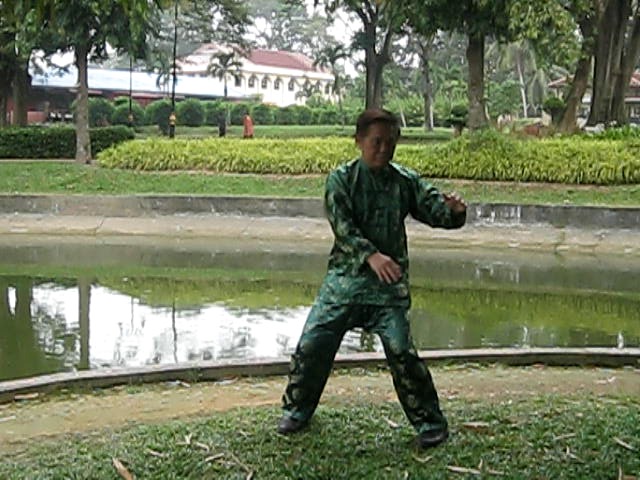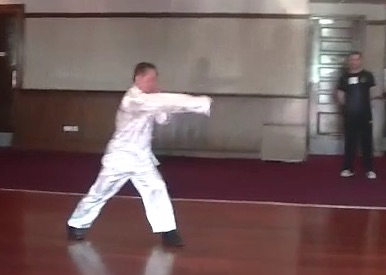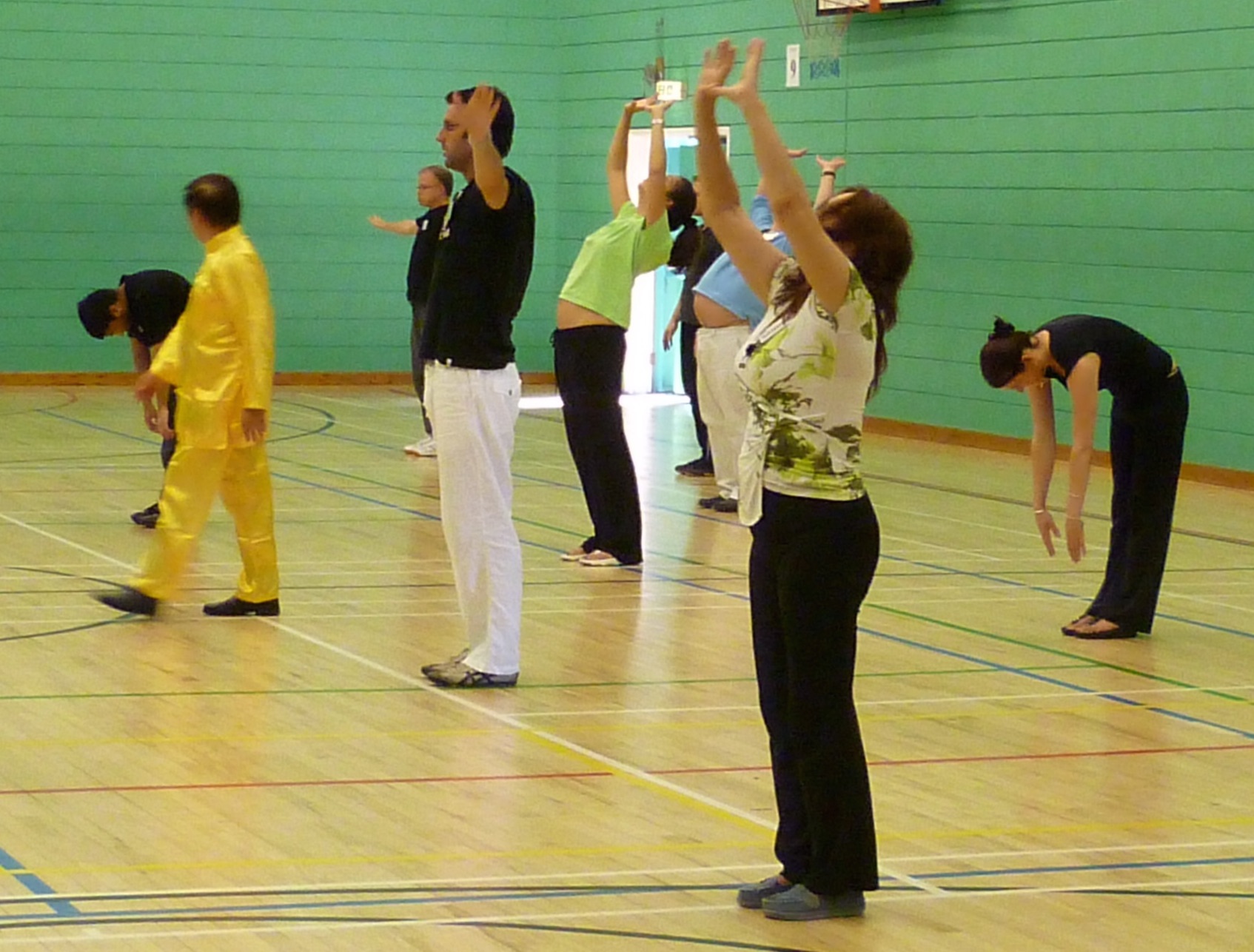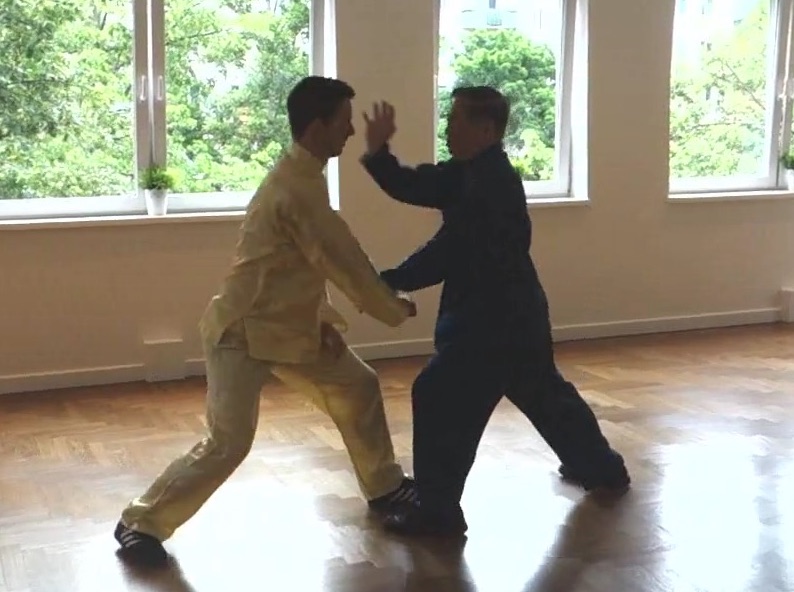SELECTION OF QUESTIONS AND ANSWERS
JANUARY 2020 PART 2

Cloud Hands
Question 1
I found various materials on the benefits and practice of Cloud Hands. Yet there seems to be very little information available on its history and origin.
— Sifu Andrea Zilio, Shaolin Wahnam Switzerland
Answer
I believe "Cloud Hands" evolved from Zhang San Feng himself when he completed his Taijiquan training, called Shaolin Kungfu at his time, and stood still at the Wuji Stance. Later when he taught his few disciples, like Tai Yi Zen Ren who became his successor, he formalized the Cloud Hands movements to "Lazy to Roll up Sleeves", which was an important and initial pattern in Chen Style Taijiquan.
I can't remember where I read about the "Lazy to Roll up Sleeves" piece, but I am quite sure it came from a Taijiquan classic. "Lazy to Roll up Sleeves" sounds similar in a Chinese dialect to "Grasping Sparrow's Tail", and that was how, the classic explained, the fundamental pattern, or section of a few patterns, of Yang Style Taijiquan got its name.
"Grasping Sparrow's Tail" contains all the fundamental patterns of Taijiquan, not just Yang Style. In another classic, "Elixir Cultivation of Zhang San Feng", Zhang San Feng or the disciple or disciples in the lineage of Zhang San Feng who wrote the classic, mentioned that Taijiquan originated from 13 techniques, which consisted of 8 fundamental patterns and 5 movements. The 8 fundamental patterns are classified into 4 main patterns and 4 secondary patterns. All the 4 main patterns are found in "Grasping Sparrow's Tail".
"Cloud Hands" came from spontaneous chi flow. I did not read this in a classic, but the idea came to me in moments of inspiration when I was in a chi kung state of mind.
Many Taijiquan masters today consider using mind to direct chi, and using chi to direct movements the highest level of Taijiquan. We disagree with this idea, as Zhang San Feng himself mentioned in his "Treatise of Cultivation Spirit and Nourishing Energy" that the highest level of his art, which later evolved into Taijiquan, is merging with the Tao, or in Western terms returning to God the Holy Spirit.
When I practiced Dragon Strength, I used this idea of using mind to direct chi to direct movement. At first the movements were out of their picture-perfect form, but eventually it worked very well. You had such an experience in the Dragon Strength course.
Question 2
Can you please tell me something about Chen Taichichuan "Reeling Silk". Some Chen practitioners consider it a modern invention (20th century). While this could be true for some of the specialized Chen exercises, it is so fundamental to Taichichuan that it would seem strange it was invented in modern times only.
Answer
In our school we use the term "spiral force" instead of "reeling silk" in Chen Style Taijiquan. In Taijiquan classics, the term used was "cocoon force", or "chan si jing" in Chinese, i.e. internal force as a result of spiral movement like a butterfly spiraling or reeling silk to make a cocoon.
I find that "cocoon force" or "reeling silk" may have a negative connotation in English, so I use "spirial force". "Bow Arrow Thrust Punch", which was found in the Taijiquan practiced by Zhang San Feng and in Chen Style, is an excellent pattern to develop spiral force. You can find me teaching this pattern in videos in my website. In Yang Style Taijiquan, an excellent pattern is "Single Whip", but one should first develop some internal force using "Bow Arrow Thrust Punch".
I discovered "spiral force" while practicing on my own. Spiral force is applicable to all kungfu, and not a specialized method in Chen Style Taijiquan. It is mentioned in some classics, including outside Taijiquan classics. The principal concept is that energy comes from the dan tian, and the main method is rotation of the waist. The arm also rotates, like the way we perform a punch.
Spiral force, or "reeling silk" as called by many Taijiquan practitioners, is certainly not a modern invention. "Cocoon force", which "reeling silk" contributes to, was already mentioned in the past.
You are right to say that Cloud Hands exercises are so fundamental to all styles of Taijiquan, not just Chen Style.

Grandmaster Wong donstrated "Bow Arrow Thrust Punch" during a Taijiquan course in Ireland
Question 3
I am 39 years old and I am a lawyer. I have practiced Kung Fu and Chi Kung as well as Aikido and Karate. I am also a Reiki Master. I practice Zen meditation and Chi kung daily.
We have read and studied some books of the Great Master: The Art of Chi Kung, The Complete book of Zen, The Complete book of Shaolin, and Chinese Medicine.
For some time now I have been practicing with my brother, with instructional videos of Grand Master Wong Kiew Kit.
Both, my brother and I wish to formally study the tradition of Shaolin Wahnam and become instructors in our country.
— Roberto, Columbia
Answer
Thank you for your e-mail which has been forwarded to me by my secretary. It is great to know of your background and your profession.
What I say, of course, does not refer to you in particular, but a lot of martial art schools today do not teach what we believe to be genuine martial arts. I must clarify that honestly I do not mean to belittle these martial art schools, though many people may be angry at my statement.
The basic benefit of any martial art is to enable practitioners be able to defend themselves and their loved ones, but most martial artists do not have this benefit. They merely exchange blows. Today, more important and immediate benefits are to be healthy, full of vitality, and have longevity, but unfortunately most martial artists today do not have these benefits.
Worse, many martial artists today, especially more advanced ones, sustain injuries and are angry or depressed. If some martial artists are healthy, full of vitality and have longevity, which I honestly wish them to have, it is because of other factors, and not because of their dedicated training.
It is actually easy to learn from me, especially for those who have kungfu experience. Attain my Intensive Shaolin Kungfu Course or Intensive Taijiquan Course. They can check available dates at my website.
It is understandable that experienced martial artists may wonder what they can learn in a few days of my intensive courses. They would prefer a more longer training program.
Honestly, they can learn a lot in just a few days of my intensive courses, especially things that are very important in kungfu training, and things that they are unlikely to learn elsewhere. Besides other benefits, they will learn how to apply their kungfu techniques for combat and how to develop internal force. Yes, they will be able to use their kungfu techniques and develop internal force during the few days of an intensive course.
Dedicated kungfu practitioners will be very happy if they can learn how to use their kungfu techniques for combat and to develop internal force in a few years. But they will learn these in a few days of my intensive course. It is just incredible. If they do not have these benefits, they can ask for a full refund of the course. They will need to practice on their own to be skillful when they return home.
One has to be a good student before he becomes an instructor. Most importantly, he must have good character and follow and practice in his daily life the Ten Shaolin Laws. There should also be a need for instructors in his area. In the appointment of instructors, I am quite traditional. I usually appoint the most senior in the area.
Question 4
How do I make my father happy?
— Juan, Spain
Answer
It is actually quite easy to make your father happy. When you are with him, say something that he likes to hear, but what you say must be truthful.
For example, "Practicing chi kung everyday will make you healthy" is truthful, but it may not be what he likes to hear. So don't say it.
"You can spend money in whatever way you like as there is unlimited supply of money." You father may like to hear this, but it is not truthful, so don't say it.
"You are my father, and I'll honour you although sometimes we have differences of opinions." This is what your father likes to hear, and it is truthful. So, say it.
Spend quality time with your father. Make it a point that you will spend at least half an hour with him every day. Ask him to tell you stories of his younger days. Soon you will find that you have made your father very happy.

Cosmic Shower at a UK Summer Camp
Question 5
How many times do we practice Cosmic Shower? (This question was asked in the Intensive Chi Kung Course in Penang in December 2018. Because of a long waiting list, it is only released now.)
— Jawad, Pakistan
Answer
It depends on one's developmental stage.
If a person is sick, he should practice Cosmic Shower about 20% of his practice sessions. He should focus on Self-Manifested Chi Movement about 60% of his practice sessions to overcome his sickness, which is his most urgent need. For the remaining 20% he could practice Attaining Mental Clarity using Lifting the Sky, and attaining Internal Force using Pushing Mountain.
His focus on Self Manifested Chi Movement, the platinum chi kung for overcoming illness, is for his need. The other exercises to attain mental clarity and internal force, and to attain spiritual cultivation is to maintain the skills when he needs them.
If a practitioner is healthy, he can spend about 60% of his practice sessions on peak performance, which attaining mental clarity and internal force will contribute. He spends about 20% on Self-Manifested Chi Movement, and another 20% on Cosmic Shower to maintain the skills.
If a practitioner is advanced and wishes to emphasize on spiritual cultivation, like being happy and joyful every day, he should spend 60% of his time on Cosmic Shower which contributes to spiritual cultivation, 20% on attaining Mental Clarity and Internal Force, and 20% on Self Manifested Chi Movement.
For convenience, the courses can be classified into the following three categories as follows:
- For health -- including overcoming illness, and having vitality and longevity.
- For peak performance -- like attaining mental clarity and internal force.
- For spiritual cultivation -- like Cosmic Shower.
The choice is based on emphasis. If all other things were equal, Cosmic Shower emphasizes on spiritual cultivation, and Self Manifested Chi Movement emphasizes on overcoming illness. But other things are not equal. Because of his greater skills, an advanced practitioner can get more benefits than a beginner in overcoming illness by practicing Cosmic Shower than by practicing Self Manifested Chi Movement.
Question 6
My mind still wavers somewhat between wanting a wife and wanting to be free.
I stopped thinking of the woman of my dreams when I was younger because I probably felt I didn't deserve her.
Can I ask how many times a day should I think of finding her?
— Name and Country Withheld
Answer
You need to decide whether wanting a wife or wanting to be free is more desirable. If you want a wife, you must make her happy. If you want to be free, you must use your freedom for your good and the good of others.
They are, however, not exclusive. It does not mean that if you want a wife, you cannot be free; and if you want to be free, you cannot have a wife. Here is where preparation is useful. You need to have a wife who also wants you to be free, though you may at times give up some of your freedom. Visualizing a wife who is kind is a good start.
You need to change your mind set. You must stop thinking of the woman of your dreams whom you don't deserve. You must always think that you deserve the woman of your dreams because you are going to make her happy.
It is sufficient that you think of the woman of your dreams twice a day -- once in the morning and once in the evening or at night. There are other important things in life than finding the woman of your dreams.

Grandmaster Wong brushed off Sifu Leo's attack and applied "Hungry Tiger Catches Goat" at Sifu Leo
Question 7
If all things were equal, would it be better if a Chin-Na practitioner is also a Tiger person? Would it be better for someone who is not a Tiger person to use other patterns than for instance Hungry Tiger Catches Goat?
— Sifu Roeland Dijkema, Shaolin Wahnam Holland
Answer
If all other things were equal, it would be better for a "tiger person" to be a chin-na practitioner. If all other things were equal, it would be better for someone who is not a "tiger-person" to use other patterns, other than "Hungry Tiger Catches Goat".
But all other things are not equal, and in your case it is by a very, very big margin. Not many people, for example, have the rare opportunity to learn in Shaolin Wahnam. You will apply "Hungry Tiger Catches Goat" much better than most "tiger persons".
If all other things were equal, the Flower Set is most suitable for you. I am happy that your favourite combat sequence is from the Flower Set.
Question 8
Sifu, after over-cleansing, do we lose the internal-force and power we have built up? And having lost it, can we still reach our potential again?
— John, Ireland
Answer
You do not lose the internal force and power after over-cleansing, though it may take you some time to recover the former internal force and power.
LINKS
Selected Reading
- Cloud Hands, Grasping Sparrow's Tail, and Cloud Hands Grasp Sparrow
- The Wonderful Intensive Shaolin Kungfu Course
- Happy and Healthy Attitude towards Life
- The Marvelous Sword against the King of Weapons
- Arches in the Snow
